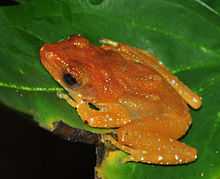Nyctixalus
| Nyctixalus | |
|---|---|
 | |
| Nyctixalus pictus | |
| Scientific classification | |
| Kingdom: | Animalia |
| Phylum: | Chordata |
| Class: | Amphibia |
| Order: | Anura |
| Family: | Rhacophoridae |
| Subfamily: | Rhacophorinae |
| Genus: | Nyctixalus Boulenger, 1882 |
| Species | |
|
See text. | |
Nyctixalus is a genus of frogs in the family Rhacophoridae. The common name is Indonesian tree frogs. They can be found in the Malay Peninsula, Sumatra, Java, Borneo, the Philippines, and southern Vietnam. Nyctixalus is the sister taxon of Theloderma.[1]
Description
Nyctixalus are medium-sized frogs with adults being 30–40 mm (1.2–1.6 in) in snout-vent length. Their body and limbs have numerous spiny tubercles. Fingers are free or webbed at base. Vocal sac is always absent.[2]
Species
There are three species in the genus:[1]
- Nyctixalus margaritifer Boulenger, 1882
- Nyctixalus pictus (Peters, 1871)
- Nyctixalus spinosus (Taylor, 1920)
In addition, Nyctixalus moloch (Annandale, 1912) is sometimes included in this genus. It has also been placed in Theloderma, but its placement is still pending further studies.[3]
References
- ↑ 1.0 1.1 Frost, Darrel R. (2013). "Nyctixalus Boulenger, 1882". Amphibian Species of the World 5.6, an Online Reference. American Museum of Natural History. Retrieved 15 November 2013.
- ↑ Li, Jiatang; Dingqi Rao; Robert W. Murphy; Yaping Zhang (2011). "The systematic status of rhacophorid frogs". Asian Herpetological Research 2: 1–11. doi:10.3724/SP.J.1245.2011.00001.
- ↑ Frost, Darrel R. (2013). ""Theloderma" moloch (Annandale, 1912)". Amphibian Species of the World 5.6, an Online Reference. American Museum of Natural History. Retrieved 15 November 2013.